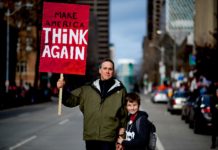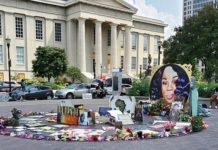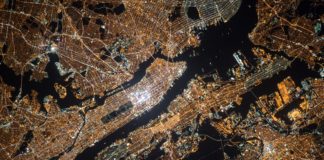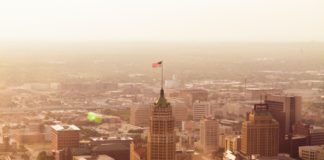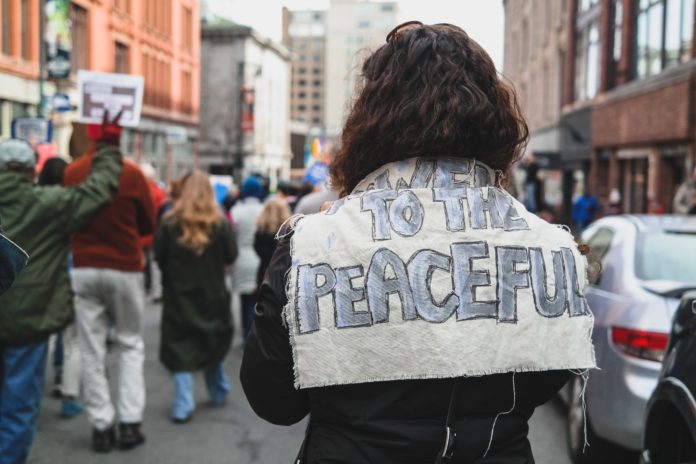
In these days of urban uprising, pandemic devastation and federal shock troops marching on America’s cities, it is nonetheless a moment for mayors, city council members and other city leaders. Your honors, please take a bow.
Not a deep bow, mind you. Events are moving too fast. This week’s tear-gassing of Portland Mayor Ted Wheeler, as a “Wall of Moms” sought to cordon off a federal militia from peaceful protestors, is a case in point. No time-out for you and your work on the stage of democracy — locally, nationally and globally. A simple, curtsy-like bob will do.
That said, a quick acknowledgement of the fuller picture of a still hard-to-define but collective mobilization of local governments is in order. For our view of the eruptions spreading from this grinding clash between the tectonic plates of governance, what we’re conditioned to perceive as a senior-junior hierarchy, is incomplete.
One insightful observer, the Atlantic’s David Graham, described what we’re witnessing as a move by President Donald Trump to cobble together what we’ve never had before – a national police force. It’s the unveiling, he suggested, of a kind of Ministry of the Interior. Not one to look after parks and monuments as with our own similarly named federal department, but rather something more like the Praetorian interior “VV” guard that Vladimir Putin keeps on hand. Or it might be a new unit akin to France’s national Gendarmerie, whose leader by the way, the Interior Minister, was sacked by President Emmanuel Macron a few days ago for retreating from a ban on chokeholds and encouraging taser use on protestors.
Another take on this fast-emerging local-federal standoff came from Bloomberg City Lab, a chronicler of urban politics, which sees Trump, “stoking fear and resentment of America’s cities, for the benefit of an audience of suburban voters.”
Or there’s the view of Thomas Friedman, the lead sage at the New York Times, who sees what’s unfolding as a “Wag the Dog,” exercise. “Trump is adopting the same broad approach that Bashar al-Assad did back in 2011,” Friedman wrote this week, arguing this is a page from the “Middle East Dictator’s Official Handbook.” When the people turn against you, the course of action is to turn the people against one another. If it worked for Syria’s Assad, why not for Trump?
Fair enough. All of it.
But these analyses of what’s happening fall short in one critical respect. They all see Trump as an animator, which he certainly is. But in the process of this line of reasoning, they also deny local leaders a certain agency, relegating them to a passive, even reactive role. This is not fully wrong, of course. But it is incomplete. Trump is not confronting the mayors. He’s lashing out, and pitifully so, at the mayors who are quite effectively confronting him – even if it doesn’t seem that way at this juncture.
Because the center of gravity for progressive politics and democratic commitment has been moving toward cities since long before the COVID-19 crisis, before even Trump’s 2016 election. By declaring sanctuary cities, moving ahead of virtually all major national governments on the Paris Climate Accord, increasing living wages, regulating corporate actors, cleaning up air and water, building infrastructure and sheltering the homeless and refugees, cities are the new locus of action. Importantly, this is not just an American phenomenon. In so many places, from London to Paris to Sao Paulo to Budapest to Warsaw to Istanbul and beyond, it is mayors who are turning back – or trying to turn back – a tide of nativist populism sweeping the globe. The other viral pandemic.
Austin, the first city in Texas to shelter in place, knows this well as we struggle against the confusing countermands from the president and our governor that have now made us the global epicenter of a plague that we could have – and almost did – contain. Other cities know this well too. Across so many issues.
So it’s worth stopping for a moment to consider just how the essentially leaderless Black Lives Matter uprisings have unfolded since the world’s attention was riveted by the May 25 public killing of George Floyd in Minneapolis.
We are used to thinking of history-making protests as events that happen on a national stage, on the squares of national capitals. We think of Martin Luther King Jr.’s 1963 March on Washington that drew a quarter million to the National Mall on behalf of civil rights. Or we see the 2011 protests in Cairo’s Tahrir Square that in a little more than two weeks brought down a tyrant and fueled the short-lived Arab Spring. Or the idea of protests brings to mind the Mothers of the Plaza de Mayo in Buenos Aires whose relentless protests between 1976 and 1983, in defiance of Argentina’s military junta and on behalf of their “disappeared” children, helped usher a brutal dictatorship from power.
But the BLM protests have been and are diffused, without a center. And yet they are by far the largest protest movement the nation – perhaps even the world – has ever seen. As many as 26 million Americans have joined protests of Floyd’s killing, according to a number of analyses largely based on cell phone data.
But the protests are neither highly organized nor choreographed and are hardly concentrated in the nation’s capital, despite one now-infamous event in front of the White House that presaged the anonymous forces now deployed in Portland.
In fact, on a single day, June 6, an estimated 500,000 people protested at 550 separate locations throughout the country, in cities large and small. This movement from cities upward and outward is unprecedented and it defies the tools of conventional political analyses.
Which is not to say all cities get a perfect scorecard on this or many other issues. Minneapolis, for example, is moving briskly in the face of the poorly named calls to “defund the police,” readying to truly reinvent its department as a public safety force. Austin by contrast, with its own deep history of police brutality, is playing a form of charades. As much as half of proposed cuts to police spending, a tiny $11 million out of a $440 million police budget, are set to be reinvested back in the department as training programs and pay raises.
This emergence of city leadership is very much a work in progress. But it is work, if only in its early stages. And it is progress, if modest in some quarters while bold in others.
So let’s take just a moment to view all that’s unfolding from this different vantage point. Cities are where the action is, where the future is being formed. Mayors don’t rate our applause or get to bow yet. But let’s give them a cautious thumbs-up for all they are doing. In return, they can just curtsy. The deep bow is yet to come.
Onward. Still so much to do.
If you like what you’ve been reading, please click here to subscribe and we will send you updates and our newsletter.

